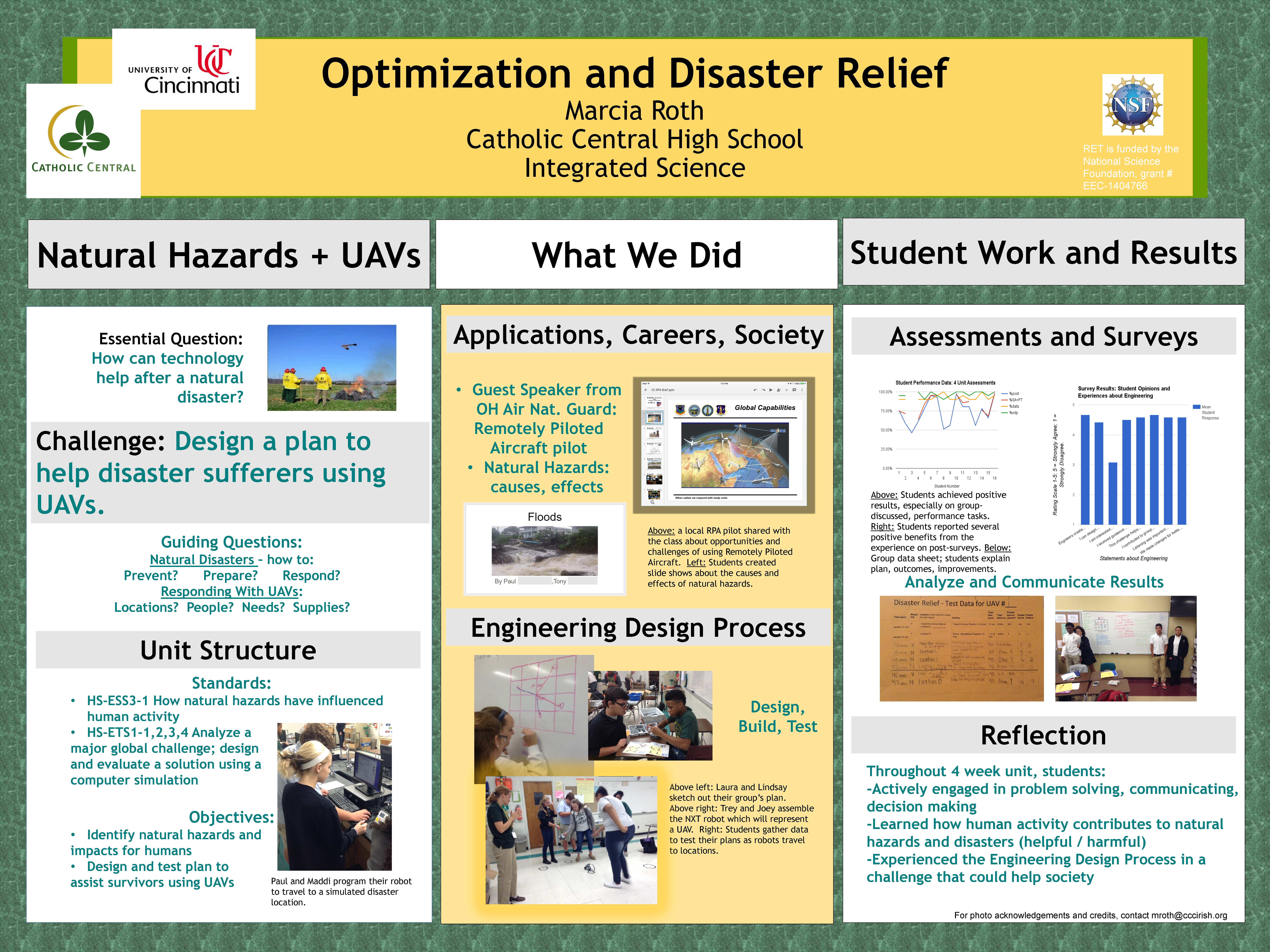Research Experience for Teachers (2015-2016)
Optimization and Disaster Relief
 |
||||||
|
||||||
|
The Big Idea (including global relevance) How can we minimize the losses from natural disasters? |
|
Essential Questions How can we save the most lives after a natural disaster? |
|
The Hook
Class visit from a local pilot from the ANG Base to talk about flying predator drones |
|
The Challenge Create a plan for assisting disaster victims quickly and safely. What actions will be taken at each location by each UAV, in what order? How can you provide the most effective aid? After you have tested and revised your plan, you will program an NXT robot to carry out your plan on a large scale (classroom floor size) map of the disaster area. |
|
Guiding Questions
|
ACS (Real world applications; career connections; societal impact)
Disaster Relief is a real-world problem students will recognize, and UAVs have many applications both currently and in the future.
Disasters disproportionately affect marginalized people; it is our responsibility as society (local and global) to seek ways to protect the health and safety of others.
UAV Pilot for Ohio Air National Guard will be a guest speaker. ; Students will have the opportunity to read and write about careers in disaster relief.; Aerospace researcher will visit or Skype with the class.
Misconceptions
- Misconceptions about Natural Hazards from: MiTEP (Michigan Teaching Excellence Program) List of Common Geoscience Misconceptions
- Natural disasters happen very rarely and these events are just the bad luck of the people that are affected. Hazards are random in both time and place and just bad luck • All natural disasters have only local effects
- Misconceptions about Earth Science by Kent Kirkby, University of Minnesota: http://serc.carleton.edu/NAGTWorkshops/intro/misconception_list.html
- Earthquakes are rare events (media coverage of earthquakes is limited and biased to U.S. area or high death tolls)
- The ground cracks opens during an earthquake to swallow people and buildings (common to Hollywood movies and popular literature like 'Clan of the Cave Bear' and Shogun', but also dates to early reports of Lisbon earthquake and confusion over landslides, etc.).
- S-waves (shear waves) do not reach other side of Earth from where earthquake originated because they cannot pass through oceans (or cannot reach islands).
- Magma comes from molten layer beneath Earth's crust (older cosmologies, Franklin's idea, as well as popular literature such as Dante's Inferno, and some religious tracts).
- Most deaths during volcanic eruptions are due to suffocation from smoke or poisonous gases (older scientific hypothesis until 1902 Pelee eruption, real life knowledge that many deaths in fires due to smoke inhalation, as well as being specifically mentioned as such in secondary education earth science films, all primarily legacy of Pompeii casts).
Unit Lessons and Activities
- Lesson 1: Natural Hazards This lesson sets the stage for the 2 part challenge in Lesson 2. Students will be introduced to UAV technology through guest speakers, then consider the global concern of Disaster Relief. After identifying Essential Questions and receiving a challenge from the teacher, students will research and make presentations about Natural Hazards and their effects on local and global society.
- Activity 1: How can we save the most lives after a natural disaster?
- Activity 2: Using online resources, work with a group to prepare a presentation (Google Slides) on one type of natural hazard (eg: earthquake, hurricane, etc): natural and other causes, historical data, effects on human activity locally and globally.
- Lesson 2: This lesson allows students two opportunities to experience the Engineering Design Process. In Activity 3, student groups will be challenged to create a disaster relief plan to use UAVs in assisting disaster victims. In Activity 4, students will learn how to program NXT robots to simulate their plan.
- Activity 3: Design a Plan
- Activity 4: Robot Simulation
- Evidence of CBL: L1A1, L2A3, L2A4
- Evidence of EDP: L2A3, L2A4
Additional Resources
Websites for Activity 1:
27 sec of Predator surveying to prep for Forest Fire mission
Amazon Testing Delivery by Drone
Why Amazon Delivery Drones Won’t Work
Robin Murphy, Disaster Relief Robots Ted talk
Websites for Activity 2:
Penn State Geography 030 course module on Natural Hazards
10 most brutal natural disasters of 2011
computers with slide show (Power Point, Google Slides, etc) technology
Andreas Rastopolous: No Roads? There’s a Drone for That (9 minutes)
